|
Collectibles of the Future
by Bob Brooke
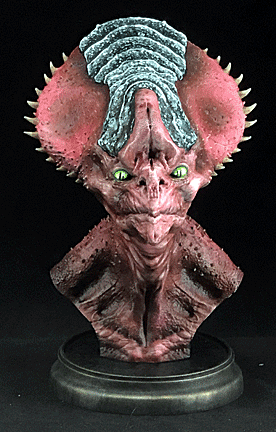 The
whole world is filled with collectibles. Some were useful items used not
so long ago—kitchen utensils, souvenirs, toys, advertising items. Others
have been produced for the collectibles market, such as decorative
plates, scale models of vehicles and airplanes, dolls, bells, and
steins. And then there are the new collectibles—the collectibles of the
future—created with modern technology and materials. The
whole world is filled with collectibles. Some were useful items used not
so long ago—kitchen utensils, souvenirs, toys, advertising items. Others
have been produced for the collectibles market, such as decorative
plates, scale models of vehicles and airplanes, dolls, bells, and
steins. And then there are the new collectibles—the collectibles of the
future—created with modern technology and materials.
And if enough people want to collect them, their value will skyrocket to
the top of the collectible charts in no time, just as Beanie Babies did,
and perhaps fall as quickly back down to the trash heap. For collectors
of future collectibles, it’s all a matter of risk.
One of the materials used by future collectibles creators is
polyurethane resin. Referred to as garage kits, these objects are often
model figures portraying humans or other living creatures. In Japan,
kits often depict anime characters, and in the United States depictions
of movie monsters are common. However, makers produce kits depicting a
wide range of subjects, from characters from horror, science fiction,
fantasy films, television and comic books to nudes and pin-up girls to
dinosaurs.
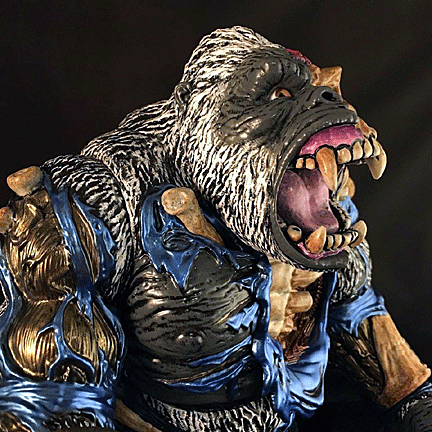 Unable
to find model kits of subjects they wanted on the market, the original
makers of garage kits were amateurs who made kits in their garages
because the toxic fumes from paints and chemicals were dangerous to
their families. As the market expanded professional companies began
making similar kits. Sometimes a distinction is made between true garage
kits, made by amateurs, and resin kits, manufactured professionally by
companies. Unable
to find model kits of subjects they wanted on the market, the original
makers of garage kits were amateurs who made kits in their garages
because the toxic fumes from paints and chemicals were dangerous to
their families. As the market expanded professional companies began
making similar kits. Sometimes a distinction is made between true garage
kits, made by amateurs, and resin kits, manufactured professionally by
companies.
Because of the labor-intensive casting process, garage kits are usually
more expensive than injection-molded plastic kits. Some figures are sold
completed, but most commonly they’re sold in parts for the buyer to
assemble and finish. Artists use Super Glue or an epoxy cement to glue
the parts together, then paints the completed figure.
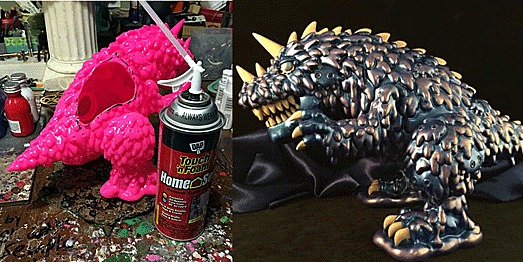
Originally, kit makers sold and traded
their products between hobbyists at conventions. As the market grew, a
number of companies began producing resin kits professionally, such as
Federation Models, Volks, WAVE/Be-J, Kaiyodo, Kotobukiya and B-Club, a
subsidiary of Bandai producing Gundam kits (Gunpla).
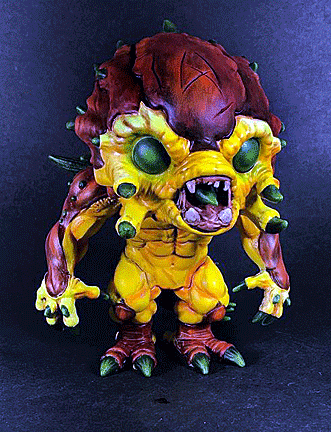 The
scale of figure kits varies, but now most are 1/8 inch. Prior to 1990
the dominant scale was 1/6 inch. This scale downsizing coincided with a
rise in material, labor, and licensing costs. Larger kits, of 1/3 and
1/4 inch scale, command higher prices due to the greater amounts of
material required to produce them. The
scale of figure kits varies, but now most are 1/8 inch. Prior to 1990
the dominant scale was 1/6 inch. This scale downsizing coincided with a
rise in material, labor, and licensing costs. Larger kits, of 1/3 and
1/4 inch scale, command higher prices due to the greater amounts of
material required to produce them.
The key to making these kits into collectible works of art lies in their
customization. Dedicated artists such as Richard Strohmeyer and Heath
Duntz are just two who have turned garage kits into spectacular pieces.
Most professionally manufactured garage kits come unpainted in a box
while amateur-produced kits sold at conventions come in a plastic bags,
blank boxes or even boxes with copied sheet information glued onto them.
Artists customize these by adding their own cast-resin parts or by
cutting into them and crafting visible working insides. They use
airbrushes as well as traditional artist brushes to achieve their
effects.
Garage Kit History
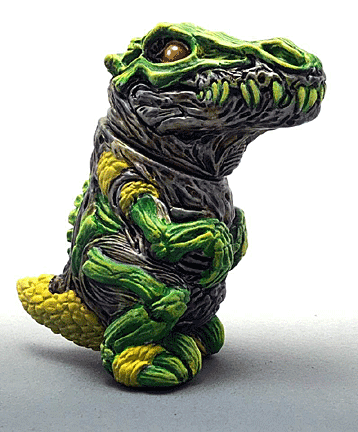 In
the 1950s and 60s Aurora and other companies produced cheap plastic
models of movie monsters, comic book heroes, and movie and television
characters. This market disappeared largely because hobbyists got bored
or frustrated with the model building kits on the market. There were
only so many cars, planes, or boats for them to build. They grew tired
of working with models that were more non-fiction based, leaving nothing
to their creative imaginations, so they started to create and build
their own models. In
the 1950s and 60s Aurora and other companies produced cheap plastic
models of movie monsters, comic book heroes, and movie and television
characters. This market disappeared largely because hobbyists got bored
or frustrated with the model building kits on the market. There were
only so many cars, planes, or boats for them to build. They grew tired
of working with models that were more non-fiction based, leaving nothing
to their creative imaginations, so they started to create and build
their own models.
However, throughout the 1980s an underground market grew through which
enthusiasts could acquire the old plastic model kits.
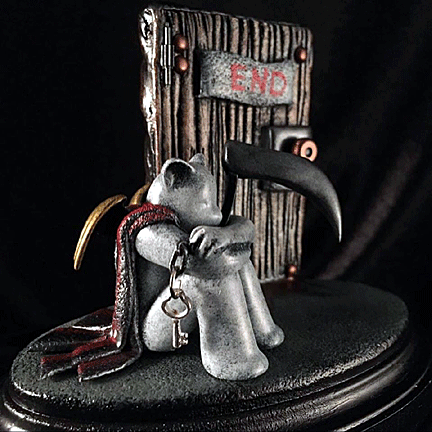 In
the early to mid-1980s, hobbyists began creating their own garage kits
of movie monsters. There was a small but enthusiastic market for these
new model kits. Makers poured resin into flexible molds which could
produce rigid reproductions of new figures. The new kits sculpted these
figures more accurately and with more detail than the old plastic model
kits. They were usually produced in limited numbers and sold primarily
by mail order and at toy and hobby conventions. In
the early to mid-1980s, hobbyists began creating their own garage kits
of movie monsters. There was a small but enthusiastic market for these
new model kits. Makers poured resin into flexible molds which could
produce rigid reproductions of new figures. The new kits sculpted these
figures more accurately and with more detail than the old plastic model
kits. They were usually produced in limited numbers and sold primarily
by mail order and at toy and hobby conventions.
In the mid- to late 1980s monster model kits went mainstream. By the
1990s, an unprecedented variety of licensed models figure kits began
appearing in hobby and comic stores throughout the US and UK as well as
Japan.
Garage Kit Production
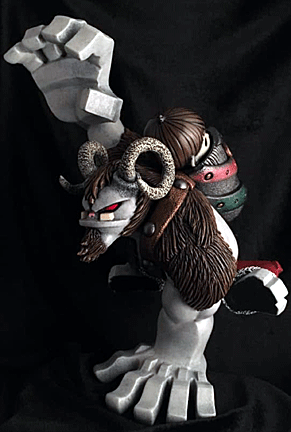 Garage
kits are generally produced in small quantities, from as few as 10 to
several hundred, compared to injection-molded plastic kits which
manufacturers produce by the thousands. This is due to the
labor-intensive nature of the manufacturing process and the relatively
low market demand. Resin casting garage kit production is the most
labor-intensive. Garage
kits are generally produced in small quantities, from as few as 10 to
several hundred, compared to injection-molded plastic kits which
manufacturers produce by the thousands. This is due to the
labor-intensive nature of the manufacturing process and the relatively
low market demand. Resin casting garage kit production is the most
labor-intensive.
Vinyl garage kits are produced by using liquid vinyl Plastisol in a spin
casting process known as slush molding. It’s more complex than resin
casting, but less expensive and less sophisticated than the injection
molding used for most plastic products and isn’t commonly done in a
garage.
Creating Resin Figures
Most garage kits are made with synthetic resin. This material is sticky
and liquid when heated to high temperatures. Unlike PVC, resin is
strong, solid and reliable after hardening in its mold.
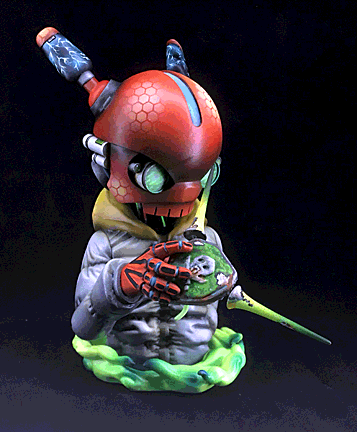 Resin
casting is a method of plastic casting where the maker fills a mold with
a liquid synthetic resin, which then hardens. Primarily used for
small-scale production, it can be done by amateur hobbyists with little
initial investment and is used in the production of collectible toys,
models and figures. Resin
casting is a method of plastic casting where the maker fills a mold with
a liquid synthetic resin, which then hardens. Primarily used for
small-scale production, it can be done by amateur hobbyists with little
initial investment and is used in the production of collectible toys,
models and figures.
Most commonly the creator of a figure uses a heat-setting resin that
polymerizes by mixing with a curing agent or catalyst at room
temperature and normal pressure.
Alternately, resin casting may be accomplished with a resin plus a
nearly equal amount of a "hardener" liquid, such as that used in epoxy,
which contains a second polymer, for use in forming a final product
plastic which is a copolymer. The synthetic resins used include
polystyrene resin, polyurethane resin, epoxy resin, unsaturated
polyester resin, acrylic resin and silicone resin.
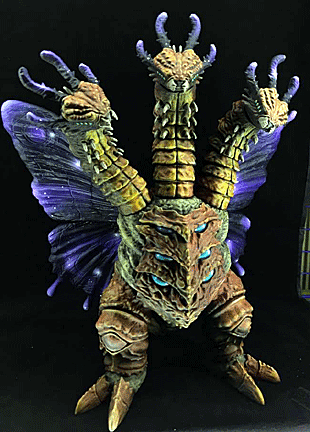 The
creator first sculpts the figure in clay, then makes a flexible mold of
it in latex rubber. To cast the figure, the maker pours the resin into
the mold and lets it seek its lowest level by gravity, insuring that the
resin gets into all the details of the mold. Mixing the two liquid parts
causes an exothermic reaction which generates heat and within minutes
causes the material to harden, yielding castings or copies in the shape
of the mold into which it has been poured. With the addition of the
catalyst, bubbles form. These must be removed by vibrating the mold. The
creator first sculpts the figure in clay, then makes a flexible mold of
it in latex rubber. To cast the figure, the maker pours the resin into
the mold and lets it seek its lowest level by gravity, insuring that the
resin gets into all the details of the mold. Mixing the two liquid parts
causes an exothermic reaction which generates heat and within minutes
causes the material to harden, yielding castings or copies in the shape
of the mold into which it has been poured. With the addition of the
catalyst, bubbles form. These must be removed by vibrating the mold.
The molds are commonly half-divided like hollowed chocolate Easter eggs.
The maker removes the hardened resin casting from the flexible mold
using a releasing agent and allows it to cool.
The end product is expensive because the rubber mold deteriorates
quickly, enabling the maker to produce only a small number of castings,
typically 25 to 100. And while the initial cost of creating a an
injection mold is higher, the mold can produce a higher number of
castings.
After the castings have cooled, they can be cut or sanded to remove any
casting artefacts like sprues and seams. Some makers assemble and paint
their products, while some models and kits, intended for consumers to
assemble, are left unfinished.
Superior Examples of Customization
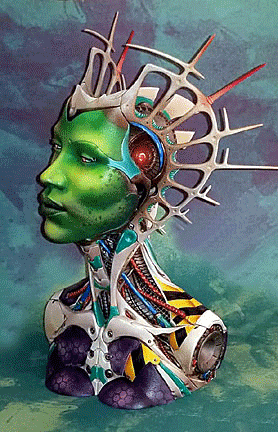 This
garage kit sculpture, called the “Sisters of Orion” by Richard
Strohmeyer transforms art through synthetic resin casted form,
originally created by Abner Marin and painted in great detail by
contemporary artist Strohmeyer. Marin originally named his piece
“Angelique.” With it, he captured the likeness of model Angela Bassett
with attention to the finest detail and with incredible precision in its
sharp, crisp metal work. This
garage kit sculpture, called the “Sisters of Orion” by Richard
Strohmeyer transforms art through synthetic resin casted form,
originally created by Abner Marin and painted in great detail by
contemporary artist Strohmeyer. Marin originally named his piece
“Angelique.” With it, he captured the likeness of model Angela Bassett
with attention to the finest detail and with incredible precision in its
sharp, crisp metal work.
But the story behind this fantastic and futuristic work of art goes back
to antiquity in ancient Greece. Once upon a time there lived seven
sisters—Maia, Electra, Alcyone, Taygete, Asterope, Calaeno and Merope---the
seven daughters of Atlas and the sea-nymph Pleione. They were the
hunting companions of the goddess Artemis. One day all seven were
playing in a secluded glade in the forest. Their laughter rang merrily
through the trees for they thought they were alone. They didn’t know
that close by the valiant hunter Orion was hunting for a deer that had
been eluding him for quite a while. He was wandering through the woods
when he heard laughter coming from the seven hidden sisters. He startled
them and they ran into the trees. From then on, Orion interrupted every
hunt that the sisters went on. He chased them relentlessly for seven
years. with the seven sisters always on the run from Orion and as each
year passed.
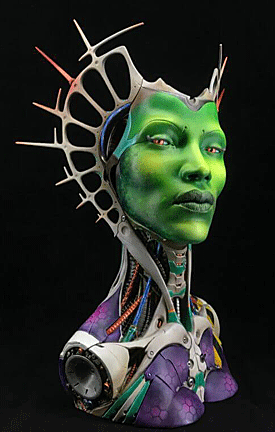 The
next time Orion cut the sisters’ hunt short, Zeus turned the seven
sisters into pigeons, and they soared into the sky. When the seven birds
had flown too far away, Zeus changed them into stars, in a cluster known
as cluster known as the Pleiades. The
next time Orion cut the sisters’ hunt short, Zeus turned the seven
sisters into pigeons, and they soared into the sky. When the seven birds
had flown too far away, Zeus changed them into stars, in a cluster known
as cluster known as the Pleiades.
Richard Strohmeyer, of St. Paul, Minnesota, mostly customizes his resin
forms and kits by creativiely painting them. “ It was a challenge to
highlight the details without desaturating everything,” he said. “I
tackled my color choices by laying them out with a color wheel. The main
objective was to run with secondary colors—green, purple and orange.
While looking at the mechanical details under the armor I couldn’t help
but think of old anatomy diagrams and gave the bigger cables an
anatomical feel. I also love to incorporate patterns. The flat planes
this piece contained allowed for some spare use of very busy elements.”
But Strohmeyer doesn’t stop there. Instead of regular paints, he uses
neon colors, which he says creates a bold statement. “With ‘Sisters of
Orion” I really wanted movement.” And he used fluorescent green and pink
in places, he placed the orange on the front, side and back. It really
shows the nooks and crannies in the design.
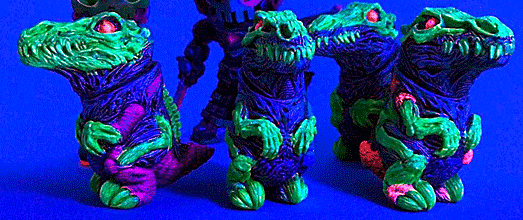
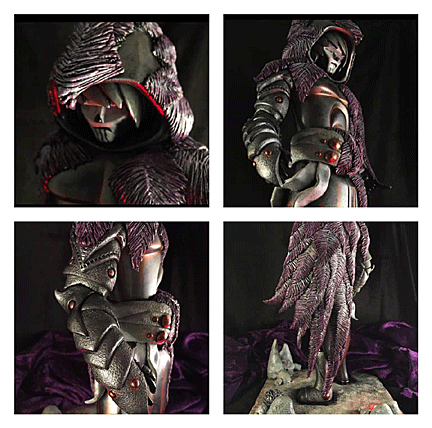 Another
artist, Heath Duntz, of Saint John, Kansas, customizes his work by
physically altering it, often by adding his own resin parts, old watch
and clock parts, and bits of antique paraphernalia. He begins with a
manufactured resin or vinyl form and then proceeds to customize it on a
theme and giving it a title, much like any other work of art. Another
artist, Heath Duntz, of Saint John, Kansas, customizes his work by
physically altering it, often by adding his own resin parts, old watch
and clock parts, and bits of antique paraphernalia. He begins with a
manufactured resin or vinyl form and then proceeds to customize it on a
theme and giving it a title, much like any other work of art.
Duntz said his process is completely visual. “I see everything as what
it could be.” He starts by simply surrounding himself with things he
finds visually interesting, then he visualizes what he imagines it
becoming. “Sometimes it takes awhile, with a lot of staring and pacing,”
he added. “I never force it. Then when I have a image in my head, I
simply make it real.” Whether it be just painting, sculptural elements,
assemblage of parts, resin work, or a bit of everything, Duntz creates
pieces that go beyond what hey were originally intended.
The amount of time each of these artists spends on each piece varies,
but needless to say, it’s labor intensive, which drives up the price of
their final pieces. But each creates something unique, not necessarily
one of a series.
<
Back to Antiques Extra! Archives
Next Editorial >
|
